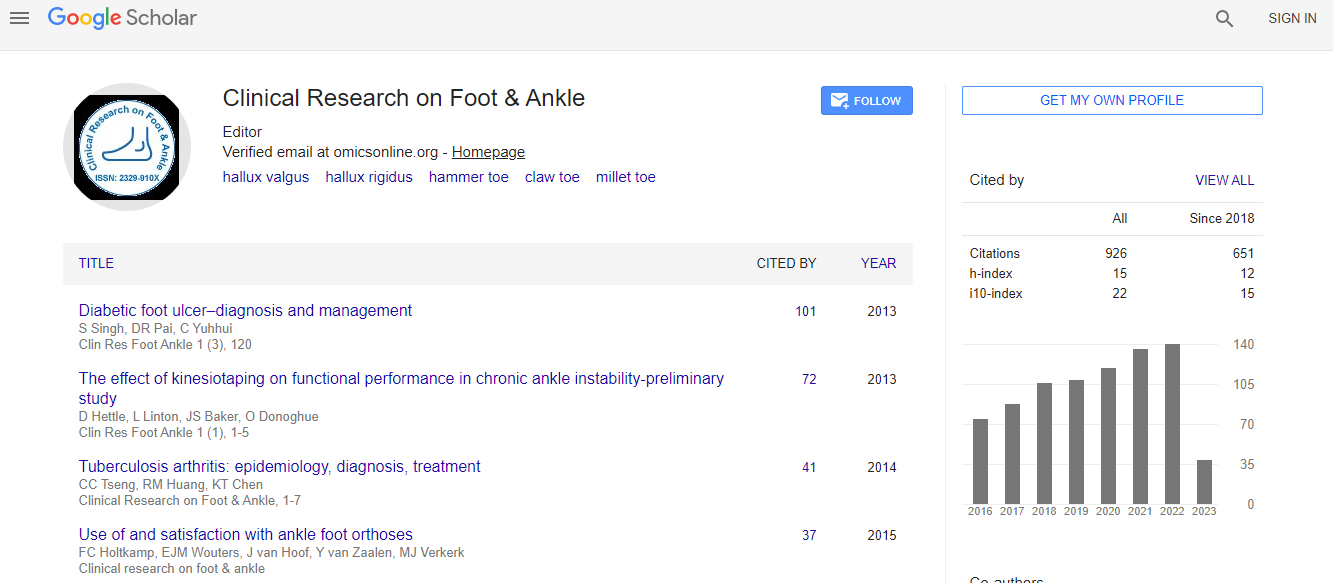Research Article
Effects of Foot Arch Structure on Postural Stability
| Emi Anzai*, Kanako Nakajima, Yumi Iwakami, Mitsuru Sato, Shuichi Ino, Toru Ifukube, Kazuhiko Yamashita and Yuji Ohta | ||
| Division of Healthcare Informatics, Tokyo Healthcare University, Tokyo, Japan | ||
| Corresponding Author : | Emi Anzai Ochanomizu University 2-1-1, Otsuka, Bunkyo-ku Tokyo 112-8610, Japan Tel: +81-3-5978-5740 E-mail: g1240514@edu.cc.ocha.ac.jp |
|
| Received December 25, 2013; Accepted February 27, 2014; Published March 05, 2014 | ||
| Citation: Anzai E, Nakajima K, Iwakami Y, Sato M, Ino S, et al (2014) Effects of Foot Arch Structure on Postural Stability. Clin Res Foot Ankle 2:132. doi:10.4172/2329-910X.1000133 | ||
| Copyright: © 2014 Anzai E, et al. This is an open-access article distributed under the terms of the Creative Commons Attribution License, which permits unrestricted use, distribution, and reproduction in any medium, provided the original author and source are credited. | ||
Related article at Pubmed Pubmed  Scholar Google Scholar Google |
||
Abstract
Background: In many human postural studies, the foot is considered to be a rigid body. The human foot is composed of the arch structure, which is characteristic in every person and deforms with aging. Foot arch structure is assumed to effect postural control; however, underlying mechanisms remain unclear. The aim of this study was to elucidate the relationship between the structure of the foot arch and postural control in the elderly.
Methods: [Protocol 1] Thirty-seven healthy subjects participated in a test to determine the relationship between midfoot plantar pressure and arch height. Midfoot plantar pressure distribution (ratio of MP) was measured using the Shoe Type Stabilometer. The arch height was measured using a three-dimensional foot scanner.
[Protocol 2] Ratio of MP and postural stability was measured in 143 elderly subjects using the Shoe Type Stabilometer. Postural stability was evaluated by center of pressure (CoP).
Results: In Protocol 1, the correlation coefficient between the ratio of MP and ratio of arch height was r=−0.59 for the left foot and r=−0.54 for the right foot. Therefore, arch height could be predicted by ratio of MP. In Protocol 2, a significant correlation was recognized between the ratio of MP and lower limb strength, CoP total length, area anterior-posterior length, and medial-lateral (ML) length.
Conclusions: The Shoe Type Stabilometer could evaluate CoP and foot arch structure. Using this device, it was found that people with a high ratio of MP, who tends to be flat-foot, displayed an increase in CoP sway. Therefore, foot arch structure contributed to postural control. Correlation between the ratio of MP and ML length, and between the ratio of MP and lower limb strength, indicated that the function of the plantar intrinsic foot muscles, which contributes to foot arch structure.

 Spanish
Spanish  Chinese
Chinese  Russian
Russian  German
German  French
French  Japanese
Japanese  Portuguese
Portuguese  Hindi
Hindi 
